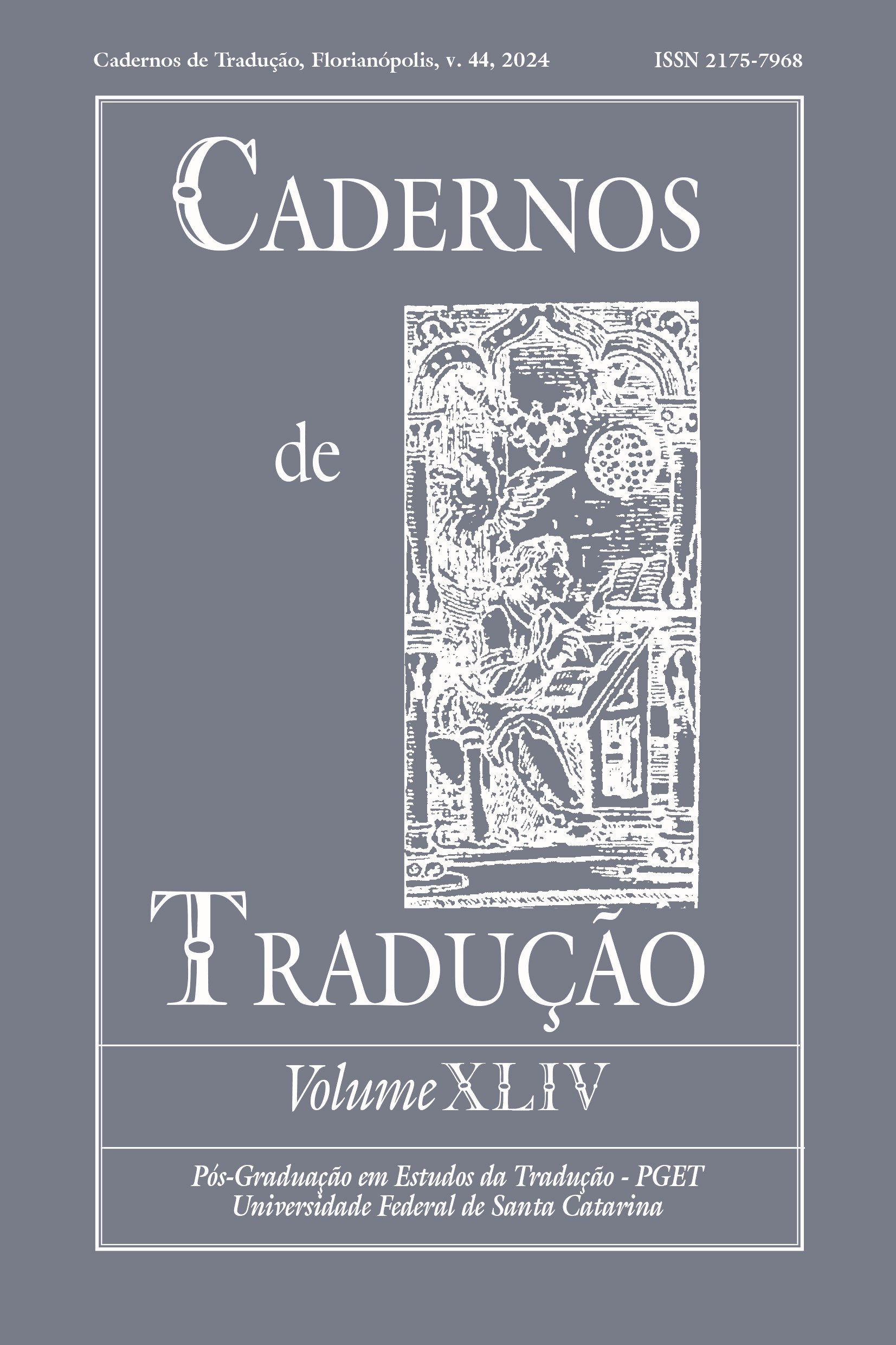El tratamiento de las unidades de significación especializada en un doble marco situacional de cara a su traducción: un caso práctico
DOI:
https://doi.org/10.5007/2175-7968.2024.e94212Palavras-chave:
marco situacional monolingüe, marco situacional bilingüe, unidades de significación especializada, variación sociolingüísticaResumo
Este artículo tiene como objetivo analizar la variación sociolingüística de unidades de significación especializada (USE) a partir de un corpus en español referente a la fase de detección del cáncer de piel, con vistas a ser traducido al francés. Asimismo, el artículo se enmarca en una investigación traductológica contrastiva más amplia llevada a cabo sobre el marco situacional de la variación lingüística en relación con las fases de prevención, detección y tratamiento de este tipo de cáncer. En lo que se refiere a la metodología, el corpus está constituido por textos procedentes del National Cancer Institute destinados a profesionales de la salud, que se desarrollan en un contexto situacional en el que el emisor y el receptor son especialistas, por un lado, y por textos dirigidos a pacientes en un contexto situacional caracterizado por un emisor especialista y un receptor lego en la materia, por otro. Los resultados establecen pautas estratégicas comunicativas utilizadas por el emisor especialista para hacer llegar al público lego el conocimiento especializado, pudiendo contrastarse con las estrategias que se emplean cuando se dirige a otro especialista. Además, los resultados apuntan a que la variación lingüística constituye una herramienta que permite resolver la comunicación en este doble marco situacional, y cuando estos se trasladan a un marco traslativo, el traductor como mediador interlingüístico e intercultural recurre a estrategias comunicativas similares para adaptar el texto origen a los distintos perfiles de receptores.
Referências
Aijón Oliva, M. A. (2006). Variación morfosintáctica e interacción social: análisis del paradigma de los clíticos verbales españoles en los medios de comunicación. Ediciones Universidad de Salamanca.
Cabré, M. T. (2002). Análisis textual y terminología, factores de activación de la competencia cognitiva en traducción. In A. Alcina Caudet & S. Gamero Pérez (Eds.), La Traducción Científico-Técnica y la Terminología en la Sociedad de la Información (pp. 87–106). Publicaciones de la Universidad Jaume I.
Cobos López, I. (2019). Traducir para el paciente: acercamiento y adaptación como modalidad de traducción. Quaderns de Filología: Estudis Linguistics, 24, 211–228. https://doi.org/10.7203/qf.24.16307
Cobos López, I. (2021). La medicina gráfica como herramienta para la traducción y la adaptación de textos biosanitarios. Mutatis Mutandis: Revista Latinoamericana de Traducción, 14(2), 397–426. https://doi.org/10.17533/udea.mut.v14n2a06
Delbecque, N. (1992). Por qué y cómo integrar la variación en la descripción gramatical. Lingüística Española Actual, 14(1), 5–68.
Eckert, P. (2012). Three Waves of Variation Study: The Emergence of Meaning in the Study of Sociolinguistic Variation. Annual Review of Anthropology, 41, 87–100. https://doi.org/10.1146/annurev-anthro-092611-145828
Fasold, R. (1990). The Sociolinguistics of Language. Blackwell.
Fishman, J. A. (1971). Sociolinguistics: A Brief Introduction. Newbury House.
Institut National du Cancer. [Consultado en 16 diciembre 2022]. https://www.e-cancer.fr/
Instituto Nacional del Cáncer. [Consultado en 15 diciembre 2022]. https://www.cancer.gov/espanol
Labov, W. (1972). Sociolinguistic Patterns. University of Pennsylvania Press.
López Morales, H. (2006). El estudio de la variación sintáctica: Precisiones metodológicas. In J. L. Blas Arroyo, M. Velando Casanova & M. Casanova Ávalos (Coords.), Discurso y sociedad: contribuciones al estudio de la lengua en contexto social (pp. 81–98). Universitat Jaume I, Servei de Comunicació I Publicacions.
MedlinePlus. [Consultado en 15 diciembre 2022]. https://medlineplus.gov/spanish/
Montero Martínez, S., Faber Benítez, P., & Buendía Castro, M. (2011). Terminología para traductores e intérpretes: Una perspectiva integradora. Tragacanto.
Moreno Fernández, F., Samper Padilla, J. A., Vaquero, M., Gutiérrez Araus, M. L., Hernández Alonso, C., & Gimeno-Menéndez, F. (2003). (Coords.), Lengua, variación y contexto: Estudios dedicados a Humberto López Morales. Arco Libros.
Rodríguez Camacho, E. (2002). La Terminología en la formación de un traductor especializado. In G. Guerrero Ramos & M. F. Pérez Lagos (Eds.), Panorama Actual de la Terminología (pp. 307–326). Comares.
Sal Paz, J. C. (2016). El comentario digital como género discursivo periodístico: Análisis de la Gaceta de Tucumán. Aposta: Revista de Ciencias Sociales, (69), 158–216.
Downloads
Publicado
Como Citar
Edição
Seção
Licença
Copyright (c) 2024 Cadernos de Tradução

Este trabalho está licenciado sob uma licença Creative Commons Attribution 4.0 International License.
Autores têm autorização para assumir contratos adicionais separadamente, para distribuição não exclusiva da versão do trabalho publicada nesta revista (ex.: publicar em repositório institucional ou como capítulo de livro, com reconhecimento de autoria e publicação inicial nesta revista).





















































